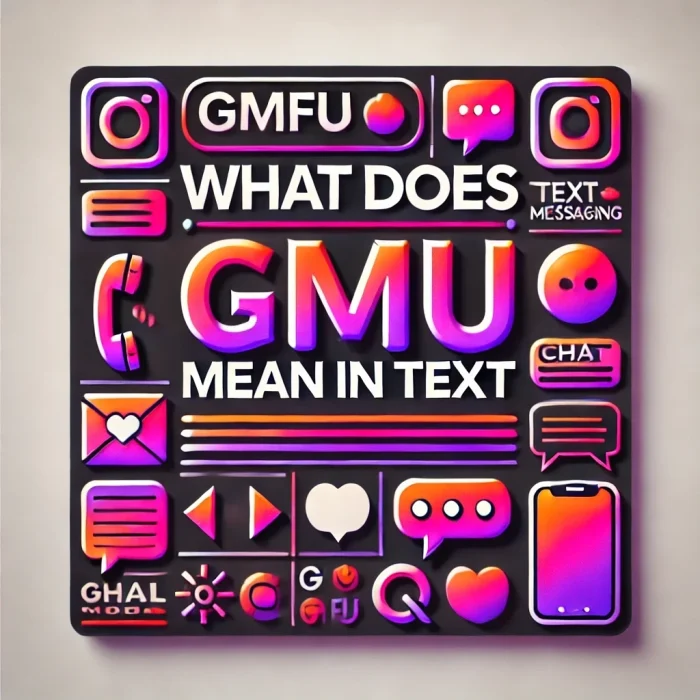What Does GMFU Mean in Text in 2025

Table of Contents
Introduction to GMFU and Its Origins
In the fast-paced world of texting, new slang terms pop up faster than you can send a message. One phrase that has gained traction in 2025 is “GMFU.” But what does GMFU really mean? As communication evolves, so do the acronyms and phrases we use to express ourselves. Understanding these terms helps us stay connected in an increasingly digital world. So, let’s dive into the origins of GMFU and explore how it fits into today’s linguistic landscape.
Evolution of Slang Terms in Text Communication
Slang has always been a part of human communication, but its evolution in text messaging is particularly fascinating. With the advent of mobile phones and apps, language adapted rapidly. New terms emerged as shorthand for convenience.
A generation ago, texting was limited to characters per message. This restriction birthed acronyms like “LOL” and “BRB.” Today’s landscape is different; character limits are less of an issue, yet brevity remains king.
Social media platforms have also played a role in shaping slang. Terms spread quickly across networks, influenced by memes and viral trends. What starts as niche can become mainstream almost overnight.
Cultural shifts further drive this change. As younger generations enter the scene, they bring fresh vocabulary that reflects their experiences and values. The dynamic nature of language keeps it alive and relevant in everyday conversation.
Popular Usage of GMFU in 2025
In 2025, GMFU has firmly established itself in digital conversations, especially among younger generations. It often appears in social media posts and private chats as a playful way to express surprise or disbelief.
The phrase “Got Me F***ed Up” captures a variety of emotions. People use it when reacting to unexpected news or outrageous comments. It’s not just limited to casual banter; you’ll find it slipping into memes and viral videos too.
Influencers have embraced GMFU, using it to connect with followers on relatable experiences. The term adds an edge that resonates with their audience.
Moreover, the versatility of GMFU means it can work across different platforms—be it text messages, TikTok captions, or Twitter threads. This adaptability keeps the slang fresh and engaging for users who thrive on rapid communication trends.
How GMFU is Used in Different Contexts
GMFU, meaning “Got Me F***ed Up,” has found its niche in various contexts. In casual conversations, it often expresses disbelief or frustration about a situation.
For instance, a friend might text you after an awkward date saying, “He said what? GMFU!” This highlights their shock and emphasizes the absurdity of the moment.
In online gaming chats, players frequently use GMFU to react to unexpected events. If someone loses unexpectedly in a match, they might type: “That lag was unreal! GMFU.” It’s shorthand for venting frustrations while keeping the tone light-hearted.
On social media platforms like Twitter and TikTok, users employ GMFU as part of humorous memes or commentary on trending topics. The phrase encapsulates collective exasperation with current events or viral challenges.
This versatility makes GMFU a staple among younger generations who thrive on quick-expression methods.
Potential Misinterpretations of GMFU
While GMFU is widely understood as “got me f***ed up,” its meaning can sometimes lead to confusion. In casual conversations, users might assume the phrase conveys humor or frustration. However, interpretations can vary significantly depending on context.
Some individuals may mistake GMFU for something more serious or alarming. If someone uses it during a lighthearted chat, a recipient unfamiliar with the slang might misread their tone and think they’re upset.
Moreover, cultural differences play a role in interpretation. What seems playful to one person may appear offensive to another. This disparity highlights how essential context is when using modern slang terms like GMFU.
As language evolves with technology and social interactions, misunderstandings are bound to happen. The nuances of communication have never been more complex, making clarity crucial in digital dialogues where meanings can shift rapidly.
The Impact of Technology on Language and Communication
Technology has reshaped how we communicate, creating a fast-paced environment for language evolution. With each new app and platform, words morph into abbreviations or symbols that capture meaning in mere seconds.
Social media platforms like Twitter and TikTok encourage brevity. Texting has led to the rise of acronyms and slang, allowing users to convey complex emotions quickly. GMFU is just one example of many terms born from this digital age.
Emojis have also become a universal language, transcending barriers. They add nuance often lost in plain text, making conversations more engaging.
Moreover, voice-to-text technology is changing our writing habits. People are speaking their thoughts rather than typing them out meticulously. This shift may lead to a more casual form of written communication over time.
As technology continues its relentless march forward, so will the ways we express ourselves through language. Each innovation paves the way for new forms of dialogue that reflect modern life.
Conclusion: The Continued Evolution of Slang in Text Communication
Language is a living entity that thrives on change and adaptation. As we navigate through the digital age, slang terms like GMFU not only reflect cultural shifts but also showcase how technology influences communication. The rapid rise of texting and social media has birthed an entire lexicon, with acronyms gaining popularity at an unprecedented rate.
The meaning of GMFU illustrates this phenomenon perfectly. It started as a playful expression within certain communities and has since grown to find its place in everyday conversations across various platforms. Its adaptability allows it to fit into different contexts seamlessly, whether it’s among friends joking around or in light-hearted banter online.
However, as with any evolving language trend, misinterpretations can arise. What one group finds humorous might not resonate the same way for another. Being aware of these nuances helps foster better communication.
As we move further into 2025 and beyond, watching how terms like GMFU evolve will be fascinating. They are indicators of societal trends and can even influence broader language practices over time. Embracing these changes allows us to connect more deeply with each other while highlighting the creativity inherent in our mode of expression.
Slang continues to shape text communication in exciting ways; it opens doors for connection while reminding us that language is ever-changing—a true reflection of human interaction itself.






